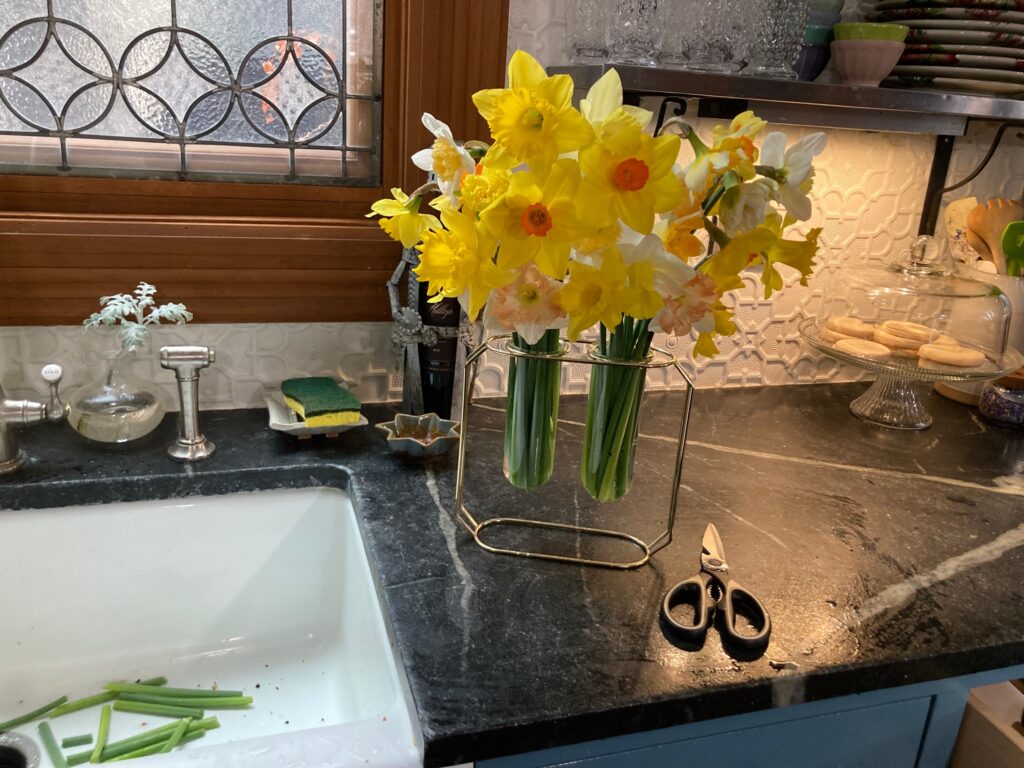I’ll be heading down to the basement shortly to transplant more seedlings; I got tired yesterday and stopped partway through. But I did take ten minutes just now to go pick some daffodils for the house.
My daffodils are White Flower Farm’s “The Works” daffodil mix — 100 for $55 (until July 1, then it goes up to $65; if you order now, they’ll ship when it’s time for planting in the fall). Daffodils are hardy in our zone and will slowly spread, so if you start with a group like that, you’ll have more and more every year.
https://www.whiteflowerfarm.com/984310-product.html
I use Martha Stewart’s method for planting bulbs — dig a big trench, throw them in (no need to fuss about with getting them pointing up, they’ll actually move around and take care of that on their own, amazingly), cover them up. Easy!
I usually layer them, biggest bulbs to smallest. So alliums at the bottom, add a little dirt, then tulips, add a little dirt, then daffodils, dirt, hyacinths, dirt, crocuses, dirt, and then all the tiny spring ephemerals, and a bit of dirt on the top. Sprinkle cayenne liberally, and they might even not get dug up by the squirrels. Some people use chicken wire, which is supposed to be an even better deterrent, but I haven’t tried that.
Daffodils are great to interplant in the garden because they contain a toxin that only a few insects can eat, and which deters deer, rabbits and other rodents. Squirrels may dig them up, but they don’t eat them.
Always remember when planting bulbs that if you want them to come back, you have to let the leaves yellow and wither on their own. That can be unsightly if you have a large bank of them, so you may want to plan for perennials that will come up soon and camouflage the withering leaves. Martha also ties hers up in little bundles, but I have no patience for that (and I don’t love how it looks either).
Hostas are one good perennial option for camouflaging daffodil foliage — here are some other suggestions: https://homeguides.sfgate.com/companion-plants-daffodils…
The Oak Park Garden Club (that our FB group is an offshoot of) periodically hosts flower arranging classes. I admit, I don’t remember very much of what the speaker said! But one thing I do is go one-by-one when I’m adding flowers to a vase. I’m looking at height, and flower and leaf shape, and if I’m not going for uniformity, I’m often aiming towards maximum variety.
I don’t want flowers to be hidden between other flowers — it helps if you know in advance where you’ll be putting the display; since I knew this was going up on the mantel, I could focus on doing an arrangement that looked good from just one direction. And this is just for me and the family, so I don’t particularly worry about it being perfect; the goal is just to have fun with it, and get to an end result that makes me happy.
Flower arranging tips:
• measure twice, cut once; once you cut, you can’t un-cut. ![]() Better to cut a little less than you think you need and then trim to fit if necessary, because you can’t make the stem longer again
Better to cut a little less than you think you need and then trim to fit if necessary, because you can’t make the stem longer again
• cut under running water for best longevity (I admit, I don’t always bother)
• some flowers don’t mix well together because of the chemicals in their sap, but I can’t remember the specifics right now — I think daffodils are best on their own?
• in general, odd numbers look more organic in design than even, both for flower arrangements and in the garden (although I did play with pairs for the mantel — two matching vases full of stems, two matching candlesticks with green candles to echo the green stems, and then a little nest with three eggs, to jazz it up a bit)




